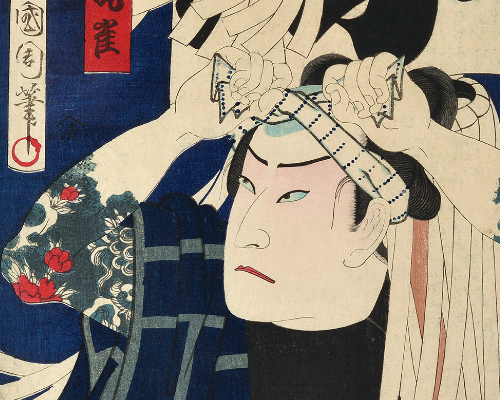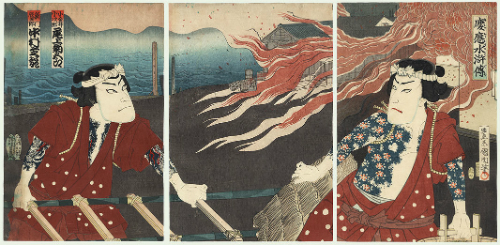
Japanese firefighters figure big in 19th century woodblock prints produced in the city of Edo (later Tokyo) between 1860 and 1890.
Nineteenth century Edo was a wooden city of a million people. Built mostly of single and double storey buildings the skyline was punctuated by tall fire watching towers belonging to the 60 separate brigades that fought the frequent fires.
Fire brigade members were part time -mostly made up of men from the building and roofing trades. The same men who put up houses had to pull them down when firebreaks were needed to prevent conflagrations spreading.
Edo firemen had a reputation for being brave, loud, drunken, violent and oversexed. They were urban street heroes of a sort. For a period it was fashionable for prints of well known kabuki actors to be depicted as Edo fire brigade leaders and shown dressed in the thick quilted jacket that were soaked and worn when firefighting and carrying a distinctive individual brigade wooden and tasselled insignia. From the 1870s onwards there were kabuki plays performed that included firemen and the artist Kunichika is particularly associated with fireman/actor images.

When the Japanese Post Office in 1998 issued two stamps celebrating firemen they copied some of Kunichika's well known lively prints and combined a 19th century fireman with a 20th century fire engine. However the post office had a big problem - 19th century Edo fireman had a passion for all over body tattoos-usually spreading down both arms. Nowadays in Japan such tattoos are associated with organised crime not with civic virtue or saving lives. To solve the problem of the wonderfully tatted Kunichika firemen the post office decided to cover up and remove the offending tattoos from the images on the stamps.
You can see these and more firemen prints in the
Edo Pop exhibition at The Lady Lever Art Gallery from until 24 Sept 2017.

 Japanese firefighters figure big in 19th century woodblock prints produced in the city of Edo (later Tokyo) between 1860 and 1890.
Nineteenth century Edo was a wooden city of a million people. Built mostly of single and double storey buildings the skyline was punctuated by tall fire watching towers belonging to the 60 separate brigades that fought the frequent fires.
Fire brigade members were part time -mostly made up of men from the building and roofing trades. The same men who put up houses had to pull them down when firebreaks were needed to prevent conflagrations spreading.
Edo firemen had a reputation for being brave, loud, drunken, violent and oversexed. They were urban street heroes of a sort. For a period it was fashionable for prints of well known kabuki actors to be depicted as Edo fire brigade leaders and shown dressed in the thick quilted jacket that were soaked and worn when firefighting and carrying a distinctive individual brigade wooden and tasselled insignia. From the 1870s onwards there were kabuki plays performed that included firemen and the artist Kunichika is particularly associated with fireman/actor images.
Japanese firefighters figure big in 19th century woodblock prints produced in the city of Edo (later Tokyo) between 1860 and 1890.
Nineteenth century Edo was a wooden city of a million people. Built mostly of single and double storey buildings the skyline was punctuated by tall fire watching towers belonging to the 60 separate brigades that fought the frequent fires.
Fire brigade members were part time -mostly made up of men from the building and roofing trades. The same men who put up houses had to pull them down when firebreaks were needed to prevent conflagrations spreading.
Edo firemen had a reputation for being brave, loud, drunken, violent and oversexed. They were urban street heroes of a sort. For a period it was fashionable for prints of well known kabuki actors to be depicted as Edo fire brigade leaders and shown dressed in the thick quilted jacket that were soaked and worn when firefighting and carrying a distinctive individual brigade wooden and tasselled insignia. From the 1870s onwards there were kabuki plays performed that included firemen and the artist Kunichika is particularly associated with fireman/actor images.
 When the Japanese Post Office in 1998 issued two stamps celebrating firemen they copied some of Kunichika's well known lively prints and combined a 19th century fireman with a 20th century fire engine. However the post office had a big problem - 19th century Edo fireman had a passion for all over body tattoos-usually spreading down both arms. Nowadays in Japan such tattoos are associated with organised crime not with civic virtue or saving lives. To solve the problem of the wonderfully tatted Kunichika firemen the post office decided to cover up and remove the offending tattoos from the images on the stamps.
You can see these and more firemen prints in the Edo Pop exhibition at The Lady Lever Art Gallery from until 24 Sept 2017.
When the Japanese Post Office in 1998 issued two stamps celebrating firemen they copied some of Kunichika's well known lively prints and combined a 19th century fireman with a 20th century fire engine. However the post office had a big problem - 19th century Edo fireman had a passion for all over body tattoos-usually spreading down both arms. Nowadays in Japan such tattoos are associated with organised crime not with civic virtue or saving lives. To solve the problem of the wonderfully tatted Kunichika firemen the post office decided to cover up and remove the offending tattoos from the images on the stamps.
You can see these and more firemen prints in the Edo Pop exhibition at The Lady Lever Art Gallery from until 24 Sept 2017.
